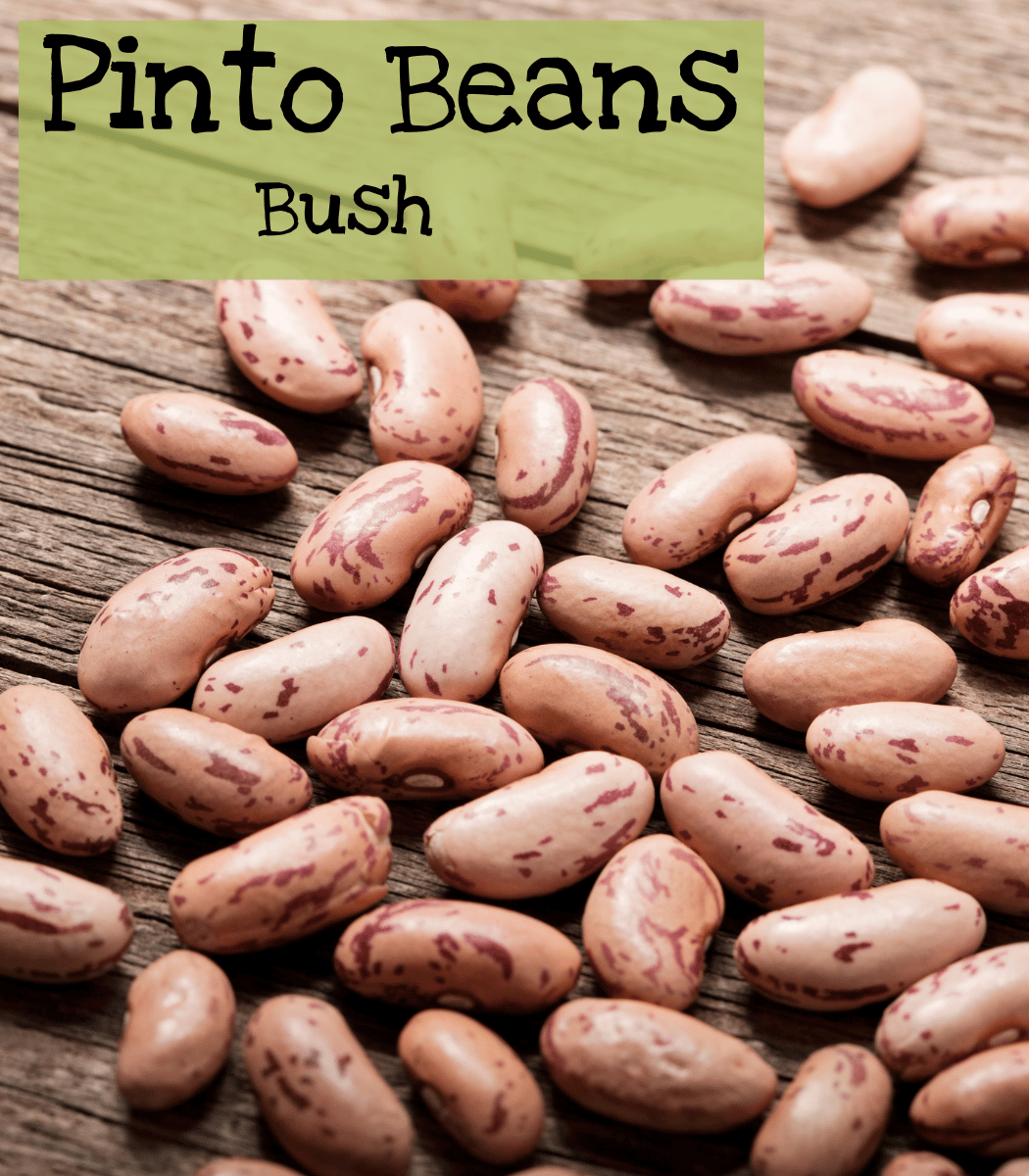
Pinto Beans
Pinto beans are used in many Mexican dishes. They are perfect for refried beans and store well as dry beans.
|
Bush Pinto Beans |
|
Phaseolus vulgaris |
|
Easy |
|
Easy |
|
4 years if properly stored |
|
Annual |
|
8-14 days |
|
Soak overnight Optional: can add a legume inoculant (follow the packaged instructions) |
|
1.5 inches |
|
15-20” |
|
Full sun |
|
90 days |
|
April, May |
|
No |

Growing Tips


When to Start
Spring: Direct sow after the danger of frost has passed.
Fall: Direct sow 10-12 weeks before the first frost. (for GA Bush–July 5-Aug 10 Pole–July 1-Aug 1)
How to Start
Know if you have bush or pole variety. Bush will typically support itself, but Pole beans require staking or a trellis.
Bush beans are also determinate, producing all at once. For a continual harvest, try succession planting. This is planting every week or every other week. Or for food preservation, plant them at the same time for a large harvest perfect for canning, freezing, or other food preservation methods.
Pole beans are indeterminate and will produce throughout the growing season.
I remember which is which by what my Mom always told me, “Indeterminate will grow into summer.” Meaning they will grow throughout the summer.
Soak the beans overnight before sowing. Direct sow to a depth of 1.5 inches deep with the eye facing down. Space 4-6 inches apart with 2 feet between rows. They like full sun beds with rich, well-draining soil. Beans do not transplant well due to their fragile root system. Plant in hills or rows. If planting Pole beans, place your stakes or trellises at the time of planting. Thin bush beans to 4-6 inches and pole beans to 7-12 inches.
Care
While pinto beans need adequate moisture they hate soggy feet. Let the soil dry out between watering as you would rosemary. Beans are a member of the legume family and as such are nitrogen fixers. They will fix nitrogen in the soil making it available for plants to take up. It is good to rotate these around for the benefit of other plants.
Rotate beans on a 3-year cycle if disease is a problem. Don’t cultivate or harvest when foliage is wet since anthracnose, bacterial blight, and rust diseases may be spread. Avoid watering the plants in the evening. Mulch plants to prevent rain from splashing dirt on beans.
Harvest
Pinto beans can be harvested as green snap beans, but are more commonly harvested for dry beans.
Harvest in the morning for peak flavor. Pole beans are ready for harvest when the pods firm but the seeds are not fully developed. Be careful to not break the stems. Bush beans are ready when they are about 3-5 inches long. To use as dried beans, allow the pods to dry and turn brown on the plant. Don’t allow them to get wet as this will cause the beans to sprout and mold in the pod. After shelling, dry an additional 2-4 weeks before storage.
Bean Don’ts
Don’t plant beans next to onions. They hate each other and neither will thrive. Other plants that don’t get along with beans are basil, kohlrabi, beets, cabbage, and fennel. Also, avoid planting near radishes.
Seed Saving

Isolation Distance
Members of the Bean Family are self-pollinating and crossing is uncommon, but rare varieties can be separated by 100 feet to ensure purity.
Instructions
Similarly colored varieties should be separated by enough distance to keep the vines from intertwining, to make them easy to distinguish at harvest.
Pick beans for seed after the pods are ripe and have dried on the plants. Don’t allow dried pods to get rained on as the beans may quickly mildew or sprout in their pods. When very dry, most pods will split on their own to drop their seeds. The rest can be easily crumbled in the hands and the finer chaff blown away after removing the big pieces. Finish drying the beans in a dry spot indoors or undercover.
A DANGER with members of the Bean Family is late summer rains, which can moisten seeds drying in their pods while still on the vine. Too much moisture during seed maturation lowers the viability and storage life of the finished seeds, and can even cause them to sprout or mildew while still on the vine.
Features
- Easy to grow
- Container friendly
- Good dried beans
- Heirloom. Traditionally used for refried beans, they cook up smooth and creamy with a great flavor. They are an excellent shelling bean with 4-6 beans per pod.

Don’t plant beans next to onions. They hate each other and neither will thrive. Other plants that don’t get along with beans are basil, kohlrabi, beets, cabbage, and fennel. Also, avoid planting near radishes.
Stop the bloat:
Eating beans can have gaseous consequences. But degassing beans is easy to do! When you cook them, add a little fresh ginger root to them. Just remove the ginger after cooking before seasoning.
For healthier eating
When trying to eat more healthfully it is important to know that legumes contain phylic acid. This acid will prevent the body from absorbing valuable nutrients.
When you eat foods high in phytic acid, the molecules bind with certain minerals in your digestive tract, including: Calcium, Magnesium, Iron, Zinc, Chromium, and Manganese.
Once this occurs, your body no longer has access to these nutrients. Generally, the more phytic acid you eat, the more minerals are blocked from your body.
However, recent studies have shown that phytic acid’s anti-nutrient effect occurs only when large amounts of phytates are consumed within a diet that is already lacking nutrition. It also only affects the absorption of nutrients eaten at the same meal.
It is very easy to break down the phylic acid that is found in beans, which will allow you to absorb nutrients. Simply soak the beans overnight and then drain off the water before cooking.
